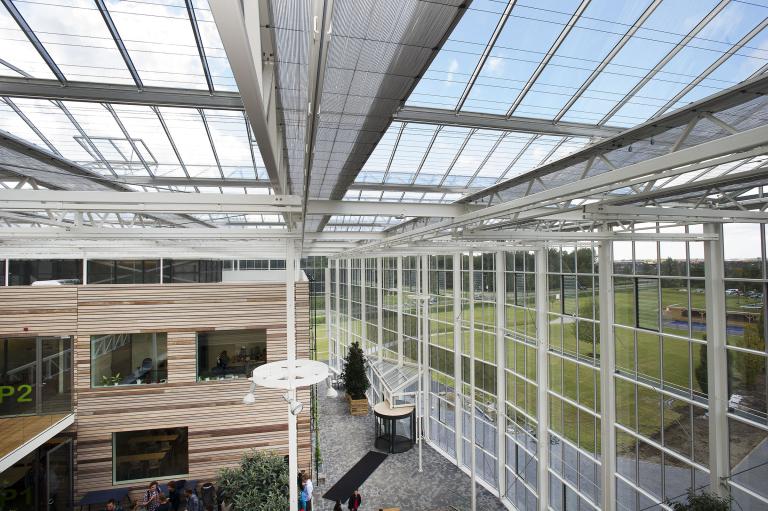Sustainable building with greenhouse technology
A greenhouse incorporates a lot of technology that is efficiently utilized to create a specific desired climate tailored to the intended yield inside.
Whether it's a production greenhouse, a tropical greenhouse, a botanical greenhouse, a sludge drying greenhouse, or any other type, all of them possess advanced climate control systems that cleverly utilize natural elements such as air, light, and solar heat.
At Forzon, we see this technology as the key to sustainable buildings.

Greenhouse technology offers a wide range of sustainable solutions for buildings, focusing on energy efficiency, sustainability, and health.
Discover how greenhouse climate control can contribute to sustainable building solutions.
- Passive heating: Greenhouses can serve as passive heating elements by capturing and dispersing sunlight, thereby reducing the need for artificial heating in adjacent buildings. This can enhance the energy efficiency of buildings.
- Natural ventilation: By employing appropriate design features and ventilation systems, a greenhouse can facilitate natural ventilation. This can decrease the need for mechanical ventilation, saving energy and improving air quality.
- Bioclimatic design: Incorporating greenhouses with bioclimatic design can reduce a building's overall energy demand by utilizing natural elements such as sunlight, shade, and passive cooling. This can help maintain a comfortable indoor environment with minimal reliance on mechanical systems.
- Food Production: Greenhouses can be utilized for sustainable food production, contributing to self-sufficiency and reducing the ecological footprint of buildings. It can aid in creating a more sustainable food system and reducing transportation-related emissions.
- Biodiversity and Carbon Sequestration: Greenhouses can be designed to promote biodiversity by supporting the growth of various plant species. Additionally, plants in the greenhouse can help absorb carbon dioxide, thus contributing to reducing the carbon footprint of buildings.
- Education and awareness: Greenhouses within buildings can serve as educational tools to raise awareness about sustainable agricultural practices, climate change, and the benefits of green architecture. This can lead to greater acceptance and implementation of sustainable solutions in the broader community.
- Light as Medicine: Natural light offers numerous benefits for both physical and mental health. It can improve mood, increase energy levels, regulate our sleep-wake cycle, enhance productivity, and improve concentration, particularly in work and learning environments. Therefore, it's essential to consider adequate natural light exposure when designing buildings and spaces.
- Creativity: Architects working with greenhouse technology consider various aspects such as the orientation of the greenhouse relative to the sun, the use of materials that retain heat, and the integration of ventilation and climate control systems. These elements can be creatively integrated into the design, balancing aesthetic and functional considerations. Additionally, greenhouse technology can be applied at various scales, from small private greenhouses to large public spaces or even integrated into buildings as atria or green roofs, allowing architects to innovate with space, light, and greenery, resulting in unique and inspiring architectural designs.
- Aesthetics: By incorporating glass extensions or greenhouses, architects can add intriguing visual elements to the design. The transparency of glass creates a sense of space and openness, making a building appear lighter and airier. Moreover, integrating greenery into the greenhouses can provide a vibrant and natural appearance, enhancing the building's harmonious and appealing look. Additionally, proper positioning and design of greenhouses can contribute to the overall aesthetics of the building. Greenhouses can serve as architectural accents or prominent features of the design, giving the building a unique and recognizable character. Therefore, the creative use of greenhouse technology can certainly enhance the aesthetic value and visual appeal of a building.
Ready for a sustainable future?
Through the smart use of climate control in greenhouses, buildings can benefit from various sustainable solutions that improve energy efficiency, health, and ecological footprint.
